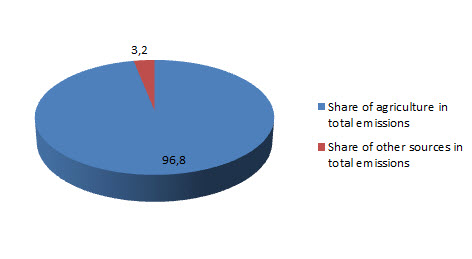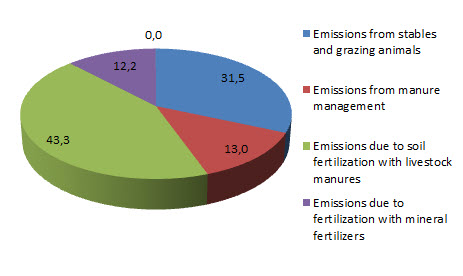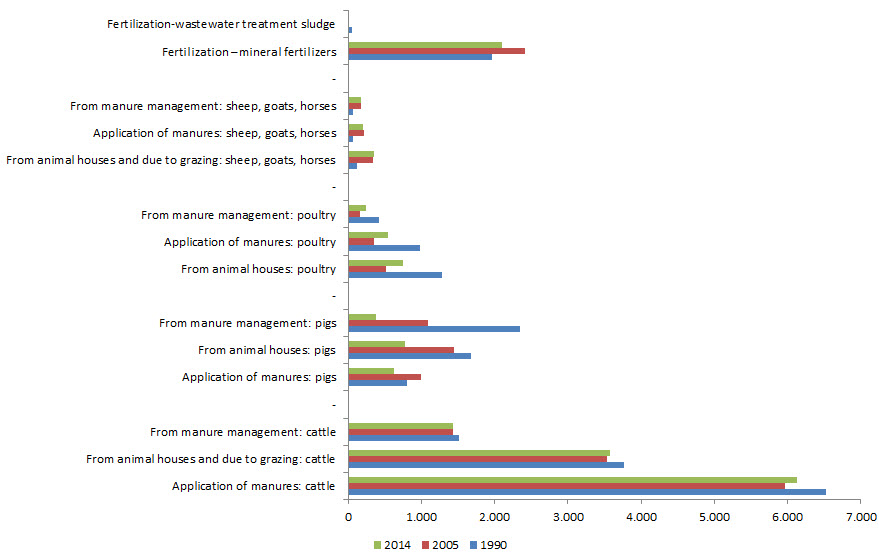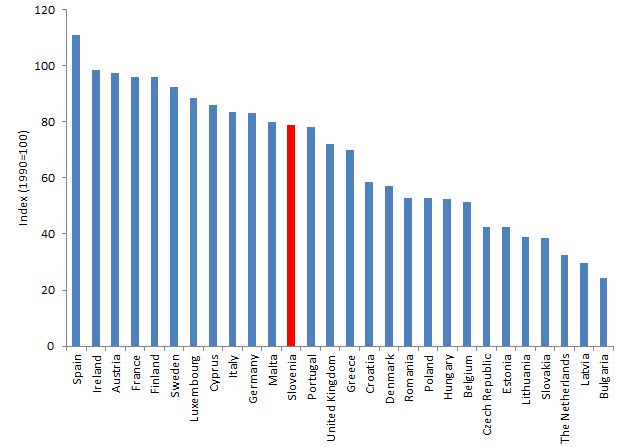[KM13] Emissions of ammonia from agriculture 

Key message

In 2013, agriculture contributed 96.8% of total ammonia emissions. In the period 1990–2014, ammonia emissions were reduced by 19.9%. In the past few years, ammonia emissions in Slovenia have been about 20% below the value determined by the adopted international commitments (20,000 t annually). Slovenia is also reaching the goal set by the CLRTAP Protocol on acidification, eutrophication and ground level ozone for 2020 (-1% compared to 2005).
Definition
This indicator shows ammonia emissions in agriculture. The main sources of emissions are presented, along with changes between the years 1990 and 2007 in total emissions and in the structure of emissions by individual sources.
Charts
Slovenian environment agency, 2015; The Agricultural Institute of Slovenia , 2015.
| 2013 | ||
|---|---|---|
| Agriculture | t/year | 16899.7 |
| Other sources | t/year | 551 |
| Total | t/year | 17450.7 |
| Share of agriculture in total emissions | % | 96.8 |
| Share of other sources in total emissions | % | 3.2 |
The Agricultural Institute of Slovenia , 2015.
| 2014 | ||
|---|---|---|
| Emissions from stables and grazing animals | % | 31.5 |
| Emissions from manure management | % | 13 |
| Emissions due to soil fertilization with livestock manures | % | 43.3 |
| Emissions due to fertilization with mineral fertilizers | % | 12.2 |
| Fertilization-wastewater treatment sludge | % | 0 |
The Agricultural Institute of Slovenia, 2015.
| Application of manures: cattle | From animal houses and due to grazing: cattle | From manure management: cattle | - | Application of manures: pigs | From animal houses: pigs | From manure management: pigs | - | From animal houses: poultry | Application of manures: poultry | ||
|---|---|---|---|---|---|---|---|---|---|---|---|
| 1990 | t | 6520.2 | 3769.2 | 1517.8 | 808.1 | 1679.9 | 2344.8 | 1284.8 | 986.3 | ||
| 2014 | t | 6122.6 | 3570.3 | 1432.7 | 622 | 778.5 | 385.9 | 750.7 | 545.4 | ||
| Changes in year ammonia emissions 1990-2014 | Index (1990=100) | 93.9 | 94.7 | 94.4 | 77 | 46.3 | 16.5 | 58.4 | 55.3 | ||
| Share in total emissons 2014 | % | 35.4 | 20.6 | 8.3 | 3.6 | 4.5 | 2.2 | 4.3 | 3.2 | ||
| From manure management: poultry | - | From animal houses and due to grazing: sheep, goats, horses | Application of manures: sheep, goats, horses | From manure management: sheep, goats, horses | - | Fertilization – mineral fertilizers | Fertilization-wastewater treatment sludge | ||||
| 1990 | t | 428.3 | 122.2 | 67.9 | 60.4 | 1962.2 | 53.7 | ||||
| 2014 | t | 251.4 | 352.3 | 207.5 | 173.6 | 2106.1 | 4.9 | ||||
| Changes in year ammonia emissions 1990-2014 | Index (1990=100) | 58.7 | 288.3 | 305.5 | 287.2 | 107.3 | 9.2 | ||||
| Share in total emissons 2014 | % | 1.5 | 2 | 1.2 | 1 | 12.2 | 0 |
Slovenian environment agency, 2015; The Agricultural Institute of Slovenia , 2015.
| Spain | Ireland | Austria | France | Finland | Sweden | Luxembourg | Cyprus | Italy | Germany | ||
|---|---|---|---|---|---|---|---|---|---|---|---|
| Annual ammonia emisssions | Index (1990=100) | 111 | 98.5 | 97.5 | 96.1 | 96.1 | 92.4 | 88.7 | 85.9 | 83.6 | 83.2 |
| Ammonia emissions - 1990 | t | 316.2 | 108 | 63.6 | 729 | 35.1 | 49 | 4.9 | 5.1 | 461.3 | 760.8 |
| Ammonia emissions - 2013 | t | 351 | 106.3 | 62 | 700.6 | 33.8 | 45.2 | 4.3 | 4.4 | 385.7 | 633.3 |
| Malta | Slovenia | Portugal | United Kingdom | Greece | Croatia | Denmark | Romania | Poland | Hungary | ||
| Annual ammonia emisssions | Index (1990=100) | 80 | 79 | 78.3 | 72.1 | 69.8 | 58.4 | 57 | 53 | 52.7 | 52.6 |
| Ammonia emissions - 1990 | t | 1.9 | 21.6 | 56.1 | 307.8 | 84.5 | 50.3 | 123.7 | 262.4 | 490.3 | 146.8 |
| Ammonia emissions - 2013 | t | 1.5 | 17.1 | 44 | 221.9 | 59 | 29.4 | 70.5 | 139.1 | 258.5 | 77.2 |
| Belgium | Czech Republic | Estonia | Lithuania | Slovakia | The Netherlands | Latvia | Bulgaria | ||||
| Annual ammonia emisssions | Index (1990=100) | 51.4 | 42.3 | 42.3 | 38.7 | 38.7 | 32.4 | 29.7 | 24.4 | ||
| Ammonia emissions - 1990 | t | 108.9 | 156 | 25 | 96.9 | 63.1 | 351.3 | 38.1 | 110.8 | ||
| Ammonia emissions - 2013 | t | 56 | 66.1 | 10.6 | 37.6 | 24.4 | 113.8 | 11.3 | 27.1 |
Goals
- To keep annual NH3 emissions under 20,000 tonnes;
- 1% reduction in NH3 emissions by 2020 compared to the 2005 level (this goal is from the Protocol to Abate Acidification, Eutrophication and Ground-level Ozone, as amended on 4 May 2012, which is not yet in force).
Comment
Ammonia is harmful to human health and the environment. It is a precursor of fine solid particles that cause lung and cardio-vascular diseases. It also contributes to acid rain and acidification of soil. Nitrogen, in the form of ammonia, is being deposited into natural ecosystems, which causes unnatural changes (eutrophication). In high concentrations, ammonia directly harms the health and well-being of people and domestic animals and is directly harmful to plants. Finally, the release of ammonia into the atmosphere causes economic damage, as it causes the loss of nitrogen as a plant nutrient.
Agriculture is the largest contributor of ammonia emissions. Most ammonia is released through fertilising with livestock manure, which is followed by emissions from animal sheds and pastures due to the storage of livestock manure and as a result of fertilising with mineral fertilisers. Large emissions from fertilisation also result from Slovenia’s lack of machines for band spreading or injection of slurry into the soil. Emissions from fertilising with these machines are much lower than from the generally practiced broadcast spreading of slurry. Taking into account emissions from fertilising with livestock manure, most ammonia is released in cattle breeding (64.3%) and pig breeding (10.3%).
Annual emissions of ammonia from agriculture in the period 1990–2014 decreased from 21,606 to 17,304 tonnes, or by 19.9%. The reduction is also characteristic for the period following 2005 (-7.3%), which is a base year for future commitments made by Slovenia in this area. Reduction of ammonia in Slovenia is comparable to the EU-28 average. In absolute terms, the greatest contributors to the reduction of ammonia are poultry and pig breeding, as the number of poultry and pigs in the observed period decreased considerably. Emissions also decreased in cattle breeding as the most important individual source. The decrease is a consequence of the reduction of the cattle population; however, the reduction of emissions did not completely follow the change in the number of animals, which is a result of increased intensity of farming. Intensive breeding is characterised by the extensive release of nitrogen, which also increases the release of ammonia. A large relative increase of emissions from horses and small ruminants is irrelevant in absolute terms, because, despite the increase, these emissions account for only 4.2% of all emissions in agriculture. Despite the reduced consumption of nitrogen from mineral fertilisers, emissions resulting from the use of mineral fertilisers increased. This is largely a consequence of the increased use of urea, which is characterised by larger emissions than other mineral fertilisers.
Reduction of ammonia emissions are also the result of regulations aimed at protecting waters, in particular, the Decree on the protection of waters against pollution caused by nitrates from agricultural sources, which determines the maximum allowed load of agricultural land with livestock and limits the use of nitrogen fertilisers on agricultural land. Reduced emissions are also a result of agri-environment-climate payments within the Rural Development Programme. Beneficiaries of such payments must comply with more stringent criteria as regards the burden of agricultural land with livestock than those prescribed by the legislation. Financial incentives for low-emission fertilisation were first introduced in 2015. They are available for band spreading and injection of slurry on meadows and fields.












